Home | Front Page | Index | Blog | New | Contact | Site Map
Lake Peten Itza
Tikal
Coban
Guatemala City
Lake Atitlan
Markets
Antigua
Rio Dulce
Esquipulas
Mundo Maya
Foto Show

Central America
Route Maps
Belize
Honduras
Nicaragua
Costa Rica
Panama
Mexico 2003-04:

|
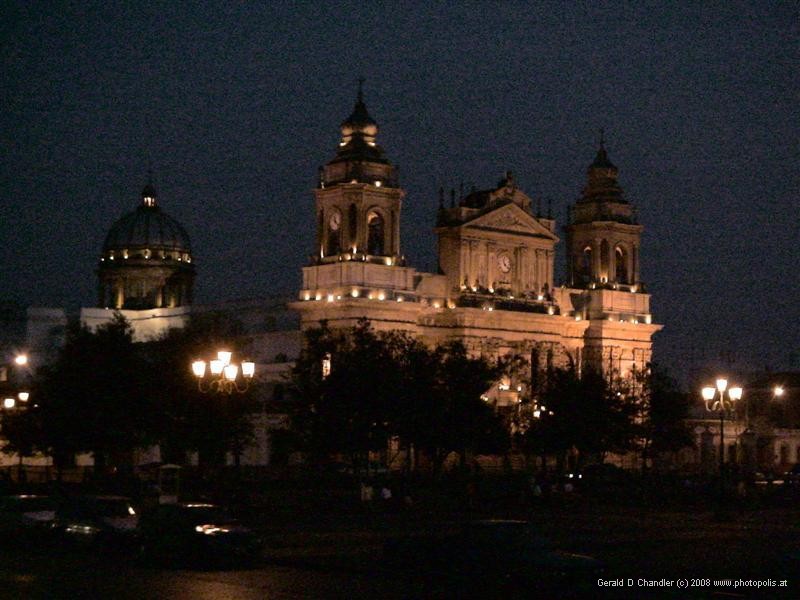
|
Guatemala City at Night
We approached Guatemala City from the northeast on highway CA-9. Our last 30 km into Guatemala City gave us our first taste of a traffic jam in this beautiful country. Driving first through mountains, and then in the outskirts of the city we were first stuck behind heavy duty trucks as they struggled uphill and then stuck behind everyone (or at least everybody not stuck behind us) as we struggled to stuff ourselves into a city that appeared to want no more cars for the moment.
Guatemala City is the "new" capital, founded in the middle of the 18th century. Guatemala City, perhaps taking a cue from Paris, is divided into "Zonas". The old center, Zone 1, where we had our hotel, is dirty and impoverished and, we are told, violent. Jan was advised by a friendly shopkeeper near our hotel to take off her gold chain in that neighborhood. But everyone we met was very friendly and we followed our usual habits of staying close to our hotel after dark.
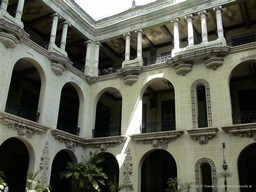
|
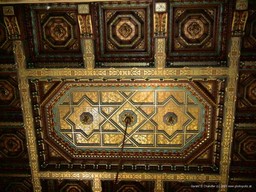
|
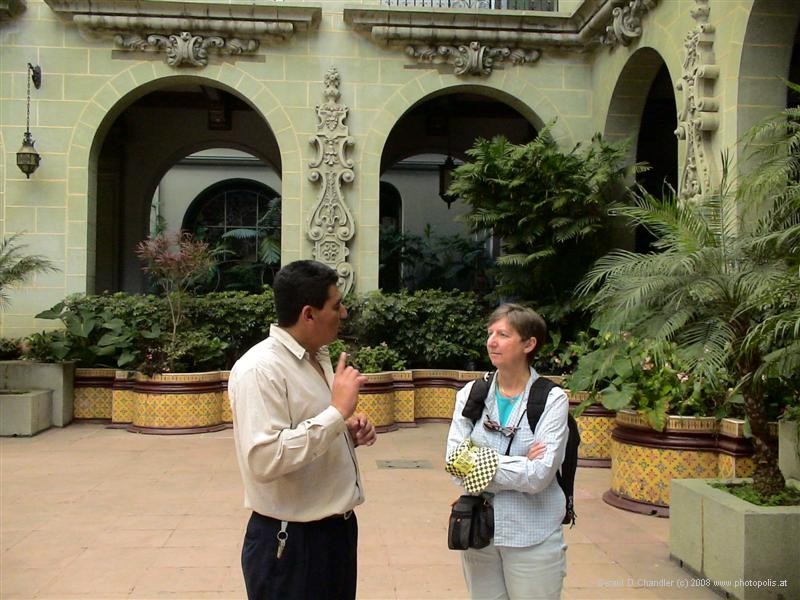
| |
Guatemala's Palacio del Gobierno
Our hotel, El Excel, was chosen for price and parking, not for location. But as to location, the down side was that we were directly under the airport landing path and had plenty of noise. The upside was that it was an easy walk to the Plaza Mayor, around which are located the oldest of the city's buildings, including the cathedral. On the north side of the plaza is a more recent building, the Palacio National, which once was the seat of the government but now is a ceremonial center. It is a lovely elegant building around two courtyards; the equal of the best in about any capital we have seen. We took the tour in Spanish and our guide, whose diction was slow and perfect, made it possible for us to understand every word.
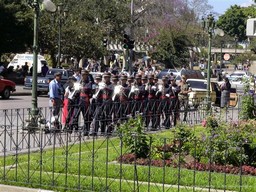
|
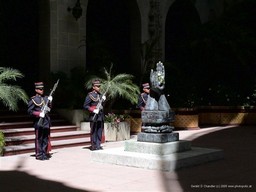
|
The Daily Ceremony to Change the White Rose of Peace
Guatemala's Palacio del Gobierno
Although it was unplanned, we were pleased to be there for the "changing of the rose" which done everyday at 11 a.m. A year after the peace accords were signed in one of the Palacio courtyards, the government erected a sculpture on the site. The sculpture is a pair of hands and in the hands a fresh white rose is placed daily. Every day, a group of soldiers from the Presidential Guard march in smartly to take away the day-old rose and replace it with a fresh one. In a nice touch, the rose is presented to the oldest Guatemalan woman in the group of onlookers. According to the tour guide, once a month on the day of the peace accords a government minister replaces the rose and once a year on the anniversary, the President does the honors.
One day we walked north to Zone 2, the site of Parque Minerva, named for an imitation Greek temple with a statue of Minerva. From old photographs it must have been impressive. Unfortunately vandals destroyed it so that its site could be reused for a baseball stadium. Could they have had as consultants the vandals who replaced New York City's Greek-revival Pennsylvania Station with today's colorless Madison Square Garden atop a buried Penn Station?
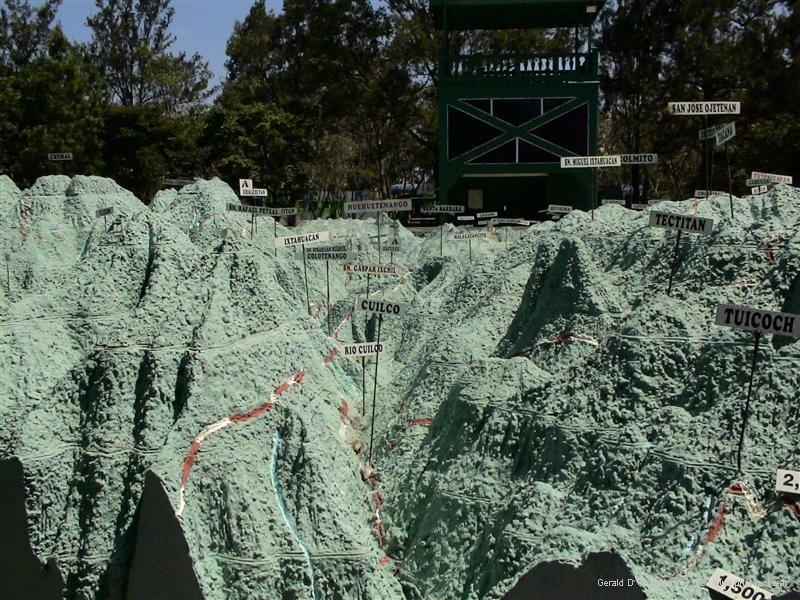
Relief Map of Guatemala in Parque Minerva |
On our way to Parque Minerva we asked directions several times. Nobody had heard of the place, even though our last interrogated people, two traffic policemen, were only 300 m away. But when we asked them how to get to the giant 3-D map of Guatemala they knew instantly. This 100-year-old three-dimensional map of Guatemala, about 40 feet on a side, greatly interested Gerry with his lifelong love of maps. The whole country, from the flat of Peten department in the north to the two major, east-west volcano-built chains of mountains in the south, was open to view. The vertical dimension is exaggerated fivefold to clearly show the country's mountains; this seemed excessive when viewed from the ground but when we climbed the viewing towers the perspective foreshortening made it just about right. Above the map we could visualize the road already traveled as well as imagine that still to come.
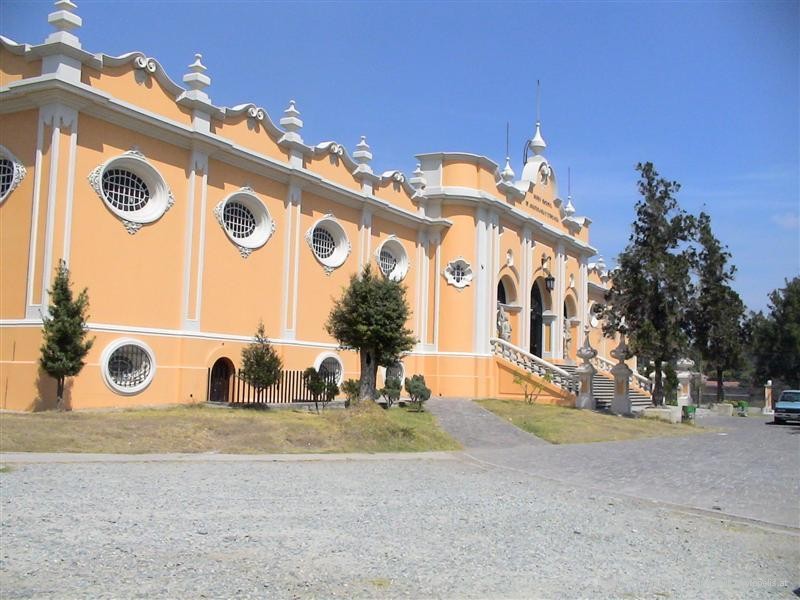
|
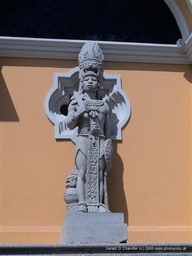
|
Museo Nacional de Arqueologia y Ethnologia
When we take up residence in a city, as we did with Paris and Jerusalem, we find the time to visit just about every museum, some twice. Here we didn't exhaust these houses of art and history. But we did get to see the Museo Nacional de Arqueologia y Ethnologia (housed in a revival Art Deco building) and the Museo Popul Vuh and Museo Ixchel del Traje Indigena (indigenous weaving and clothing). We spent three different half days at each of them. While at the last we met an American tour group that had spent about an hour at each, all in the same day, as an introduction to their tour-to-come of Guatemala. Of course lots of our time was spent in reading the Spanish-only labels and descriptions.
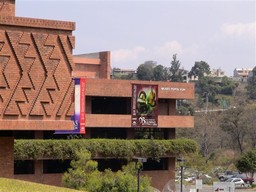
|

|
Popul Vuh and Ixchel Museums
The Popul Vuh and Ixchel museums are both housed in modern red brick buildings on the campus of the Universidad Francisco Marroquin [http://www.ufm.edu.gt], named for a 17th century priest who fought for indigenous human rights. Being at the museums gave us a chance to visit this private university. It is located in a small canyon, either naturally very green, or kept that way by excellent gardeners and landscapers. Some of the trees had parasitic orchids growing in them which, we could tell, had been inserted by gardeners. Such a contrast to the dirt of Zona 1!

|
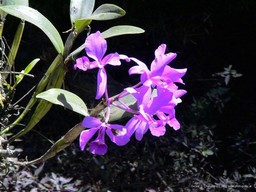
|
Francisco Marroquin University Campus
Another contrast is between the wealth of these university students (and faculty) and the relative poverty in some other parts the city. As a private university, the students (really their families) pay what in local terms is a hefty sum to attend. They drive cars and fill the large parking lot; they carry cell phones; they, like we did, eat at the expensive student center overlooking the green grounds and play video games with their portables connected.
For months, we had been telling ourselves we should get an "annual" physical exam; our last was in Darlington before we left in September, 2002. We'd skipped doing it in Mexico because when we were in big cities it was too early and we didn't go to Mexico City. As we approached Guatemala City, with its population of several million (or more, it's growing rapidly) we thought, as Joseph Smith said, "This is the place." After a false start at the Cedros de Lebanon hospital (due to taking a Spanish advertisement for health insurance as being one for health exams) we found the Hospital Universidad Esperanza and its affiliate, Clinic Herrera-LLerandi, where we were introduced to Dr. Edgar Lopez. He had trained in the USA at the Cleveland Clinic and proved to be friendly and very competent in English and medicine. Through him we each had a thorough physical exam, including EKG, chest x-rays, and full blood tests. The results seem to be fine although Gerry's high cholesterol was confirmed again and might be catching up with him. Gerry was prescribed and now takes cardiac aspirin daily and has much reduced the fat in his diet. Time will tell where things go from here.
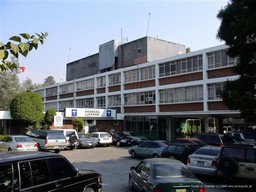
Herrera Llerandi Hospital |
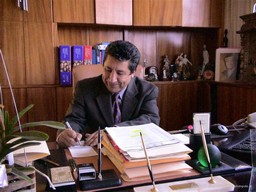
Doctor Edgar Miguel Lopez Alvarez |
The hospital and clinic sit on the boundary between Zona 9 and Zona 10, upscale parts of Guatemala City. On doctor's advice we skipped the McDonalds opposite the clinic and walked around Zona 9 looking for a healthier restaurant. There we found in an expensive commercial center TGI Fridays, where we had an excellent Thai chicken salad. We liked it so much that we came back two more times. In the same complex we found a bookstore with a selection to our liking and bought "Mundo Maya," a wonderfully illustrated guidebook, originally in French and, in our copy, translated to Spanish.
Speaking of food, we're really much more pleased with Guatemalan food than we were with Mexican food. "Tex-Mex" here is the stuff of specialty shops, not every corner restaurant. No more do we have to look long and hard to avoid fried tortillas, tacos, and refried beans. To our very pleasant surprise almost every medium size restaurant we enter has a mixed and Chef's salad. And it is easy to find economical grilled fish, both very tasty and very suitable to Gerry's new low-fat diet.